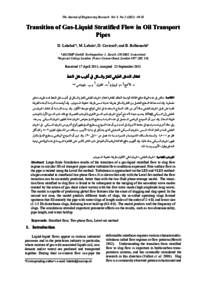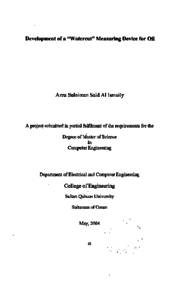Document
Transition of gas-liquid stratified flow in oil transport pipes.
Contributors
Publisher
Sultan Qaboos University
Gregorian
2011
Language
English
English abstract
Large-Scale Simulation results of the transition of a gas-liquid stratified flow to slug flow regime in circular 3D oil transport pipes under turbulent flow conditions expressed. Free surface flow in the pipe is treated using the Level Set method. Turbulence is approached via the LES and VLES methodologies extended to interfacial two-phase flows. It is shown that only with the Level Set method the flow transition can be accurately predicted, better than with the two-fluid phase-average model. The transition from stratified to slug flow is found to be subsequent to the merging of the secondary wave modes created by the action of gas shear (short waves) with the first wave mode (high amplitude long wave). The model is capable of predicting global flow features like the onset of slugging and slug speed. In the second test case, the model predicts different kinds of slugs, the so-called operating slugs formed upstream that fill entirely the pipe with water slugs of length scales of the order of 2-4 D, and lower size (1.5-1 D) disturbance slugs, featuring lower hold-up (0.8-0.9). The model predicts well the frequency of slugs. The simulations revealed important parameter effects on the results, such as two-dimensionality, pipe length, and water holdup.
Member of
ISSN
1726-6742
Resource URL
Citation
Lakehal, D., Labois, M., Caviezel, D., & Belhouachi, B. (2011). Transition of gas-liquid stratified flow in oil transport pipes. The Journal of Engineering Research, 8 (2), 49-58.
Arabic abstract
نناقش في هذه الورقة نتائج المحاكاة الواسعة النطاق لظاهرة انتقال الجريان الطبقي للغاز والسائل في أنابيب نقل النفط تحت ظروف تدفق مضطربة. وقد تمت معالجة السطح الفاصل بين الغاز والسائل بطريقة حديثة تسمى طريقة خطوط المستويات. وقد أوضحت الدراسة أن هذه الطريقة قادرة على تمثيل الجريان الطبقي بدقة أكبر من تلك النماذج المستخدمة في ثنائي الموائع متوسط الأطوار. وقد بينت الدراسة أن انتقال الجريان من الطبقي إلى السبيكي (slug) يحدث نتيجة لاندماج أمواج الجريان ذات النسق الثانوي (الموجات القصيرة) مع تلك ذات النسق الأول (الموجات طويلة السعة). وقد تبين أن النموذج الرياضي المستعمل في هذه الدراسة يستطيع التنبؤ بخواص الجريان عامة كظهور الجريان السبيكي وسرعته. وفي حالة أخرى تمت دراستها في جامعة الامبريال في لندن تبين أن هذا النموذج يستطيع التنبؤ بظهور أنواع أخرى من الجريان السبيكي في الجريان الطبقي للماء والغاز كذاك المسمى بالجريان السبيكي التشغيلي الذي يتشكل في بداية الأنبوب بسبائك من الماء بطول قطري 2-4 وكان أقل قطر هو 1-1.5 والمسماه بالسبائك التشويشية والمتميزة بنسبة ماء تصل من 80 إلى 90%. وقد تبين أن النموذج الرياضي يستطيع التنبؤ بتكرار ظهور الجريان السبيكي بدقه عالية. وقد أظهرت نتائج المحاكاة الرياضية أن العوامل ذات التأثير الكبير على الظاهرة المدروسة في هذه الورقة هي نوعية التدفق وطول الأنبوب ونسبة الماء.
Category
Journal articles


